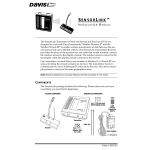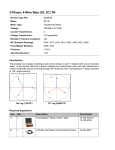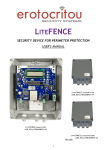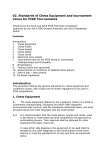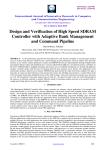Download - Arbiter Systems, Inc.
Transcript
Using SensorLinkLitewires with the Arbiter Systems 928A Power System Multimeter R Document No. PD0043800A Arbiter Systems, Inc. 1324 Vendels Circle, Suite 121 Paso Robles, CA 93446 U.S.A. (805) 237-3831, (800) 321-3831 http://www.arbiter.com mailto: [email protected] 1 Introduction Arbiter Systems manufactures the Model 928A Power System Multimeter. It has Floating-Point DSP Digital Signal Analysis and is an AC Power measurement instrument, providing outstanding performance and flexibility in a small, hand-held package. Not only does the Model 928A measure basic data and power quantities, but it also measures power quality including harmonics, flicker, sags, swells and interruptions. Incorporating a graphic LCD display, USB port, real time clock and an unprecedented combination of features makes the Model 928A the ideal instrument for the power professional. While the Model 928A is designed for use on low voltages, it also can measure higher voltages by R using PTs and CTs. The SensorLink Litewires provide a portable PT and CT that easily adapt and have been evaluated in Arbiters Laboratories. Litewires are designed to measure primary voltage and current, and as such are not to be left unattended. However, they are an excellent way to capture primary waveforms. The following information describes how to connect the Amp and Volt Litewire and configure the 928 for their use. 2 To connect a Volt Litewire to an Arbiter 928A: 2.1 • • • • 2.2 Required Parts R 20kV Volt Litewire SensorLink Part# 8-012-60 Hz R Dual Banana Plug to BNC Connector SensorLink Part# 7-011- CONN Coax Cable with BNC Connectors on each end Arbiter 928A Power System Multimeter Connecting the Volt Litewire to the 928A 1. Connect the Dual Banana Plug to BNC Connector to Channel A of the Arbiter 928A (see figure below). The Banana Plug has Red and Black plugs. Plug the Red lead into the Red terminal and the Black into the Black terminal. 2. Connect the BNC Cable to the Analog output from the display of the Volt Litewire. And the other end of the BNC Cable to the BNC end of the Banana Plug. 3 To connect an Amp Litewire to an Arbiter 928A: 3.1 • • • • Required Parts R Amp Litewire SensorLink Part# 8-015-60Hz or 8-016 60Hz Pomona Banana-to-BNC(m) adapter, Pomona Part# 1296 Arbiter Current Input to BNC Cable, Arbiter part# CA0027200 Arbiter 928A Power System Multimeter 2 3.2 Connecting the Amp Litewire to the 928A 1. Connect the Arbiter current cable (P/N CA0027200) into the Channel B current connector on the Model 928A (see figure below). Current inputs are at the top of the 928A. 2. Connect the banana jacks at the other end of the Arbiter current cable to the banana-to-BNC adapter. Plug the red banana plug of the current cable into the red jack of the adapter, and black banana plug into the black banana jack of the adapter. 3. Connect the BNC connector of the adapter to the BNC connector of the analog output from the display of the Amp Litewire. 4 Configure the Arbiter 928A to accept the Volt and Amp Litewire Outputs 4.1 Select the Voltage and Current Channel In this step, you will configure Channel A of the 928A to measure voltage and Channel B to measure current. For reference, see pages 19-22 from the 928A User Manual. 1. On the 928A, press keys [2nd] then [AV] to set Channel A to voltage. 2. On the 928A, press keys [2nd] then [BI] to set Channel B to current. 4.2 Configure Voltage Ratio for Channel A on the 928A In this step, you will configure Channel A of the 928A for the correct ratio to read the voltage from the Volt Litewire. The correct value for the Volt Litewire is 10,000. 1. On the 928A, press keys [2nd] then [Menu] and use the arrow keys to highlight “Ch-A, V” and press the [ENT] key. 2. In the “Ch A VOLTAGE CONFIG” screen the cursor should be resting on “INPUT RATIO”. To adjust the voltage ratio, press the [ENT] key and the cursor should move to the ratio value. Now, use the numeric keys to type in the value “10000” and press the [ENT] key. 3. If you want to enter a phase offset, set the cursor to “PHASE OFFSET” and press the [ENT] key. Use the numeric keys to enter any phase offset and press the [ENT] key. 4. To store these changes, highlight “<STOre And Exit>” and press the [ENT] key. 5. Press the [ESC] key to go back to the main screen. 3 4.3 Configure Current Ratio for Channel B on the 928A In this step, you will configure Channel B of the 928A for the correct ratio to read the current from the Amp Litewire. The correct value for the Amp Litewire is 1,000. 1. On the 928A, press keys [2nd] then [Menu] and use the arrow keys to highlight “Ch-B, I” and press the [ENT] key. 2. In the “Ch B CURRENT CONFIG” screen the cursor should be resting on “CT SELECT”. Press the [ENT] key and choose the selection, ‘USER” and press the [ENT] key. 3. In the “INPUT TYPE” selection, choose the value “Volt” and press the [ENT] key. 4. In the “INPUT RATIO” selection, choose the value 1000 and press the [ENT] key. 5. If you want to enter a phase offset, set the cursor to “PHASE OFFSET” and press the [ENT] key. Use the numeric keys to enter any phase offset and press the [ENT] key. 6. In the “LOW RANGE MODE” selection, set the value to “OFF.” 7. To store these changes, highlight “<STOre And Exit>” and press the [ENT] key. 8. Press the [ESC] key to go back to the main screen. 5 Measuring Voltage and Current The Model 928A should now be correctly configured and connected to measure primary voltage R and current using the SensorLink Volt and Amp Litewires. To read voltage and current, simply press the [VI] key. The Model 928A should be ready to indicate voltage and current when the Litewires are positioned correctly on the lines. 4




